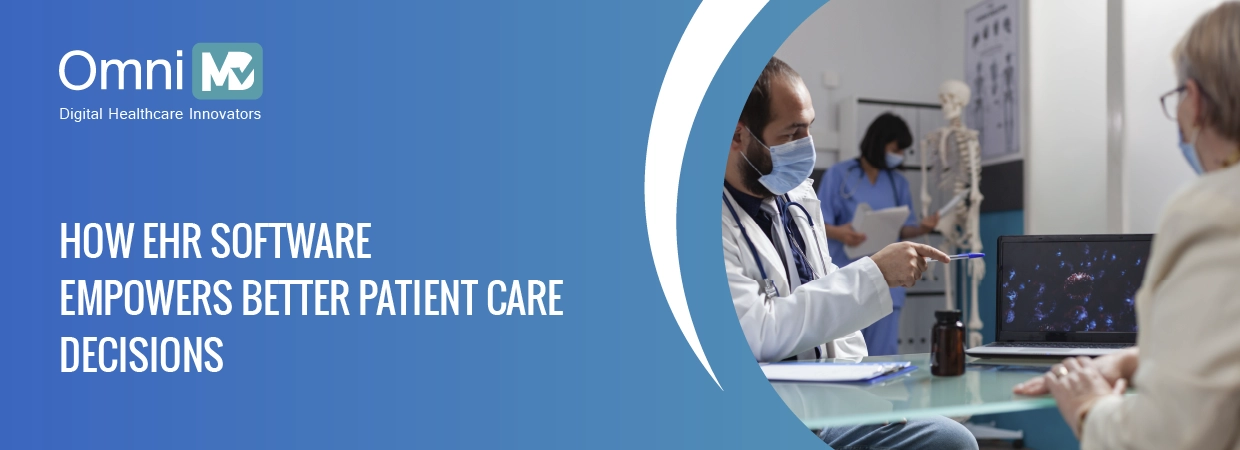How EHR Software Empowers Better Patient Care Decisions
Patient care in today’s healthcare ecosystem is increasingly complex, requiring precision, collaboration, and data-driven insights. This is where Electronic Health Record (EHR) Software comes into play, empowering healthcare providers to make better decisions and deliver higher-quality care. EHR Software has emerged as a game-changer by offering a comprehensive platform for managing patient information and facilitating clinical decision-making.

According to Statista, the global market size of EHR’s is expected to reach over 47 billion U.S. dollars.
As we move ahead, we’ll learn more about the effectiveness of EHR software systems in improved patient care.
Electronic Health Record (EHR) Software: A Brief Introduction
Electronic Health Record (EHR) software is utilized for storing, managing, and accessing patient health information digitally. EHR software systems encompass a wide range of data, including medical history, diagnoses, medications, treatment plans, immunization dates, allergies, radiology images, and laboratory test results. As opposed to traditional paper-based records, EHR software provides healthcare professionals with a comprehensive and organized view of a patient’s health information in a secure and accessible format.
During the COVID-19 pandemic, many healthcare providers rapidly shifted to cloud-based EHR systems to support remote consultations. For instance, Cleveland Clinic leveraged cloud-based EHRs to enable telemedicine, allowing doctors to access patient data securely during video consultations, enhancing patient care and safety during the lockdowns.
How Does EHR Software Work?
EHR software comes in two primary types: on-premise and cloud-based.
- On-Premise EHR: Installed on local servers, suitable for smaller healthcare organizations with a stable patient base.
- Cloud-Based EHR: Better for larger or growing organizations, allowing scalability, remote access, and seamless data restoration in case of server failure.
Use Case Scenario: Enhancing Chronic Disease Management
With the growing prevalence of chronic diseases, healthcare providers are turning to EHR software to better manage patient care. For example, at the University of California, San Francisco (UCSF), the implementation of a robust EHR system has allowed care teams to monitor patients with diabetes more effectively. By integrating patient data, such as glucose levels, medication adherence, and lifestyle factors, the EHR enables providers to create personalized care plans.
Additionally, UCSF utilized analytics tools within the EHR to identify trends in patient data, such as increased emergency room visits due to poorly managed diabetes. This insight prompted proactive interventions, including tailored educational programs and timely follow-ups. As a result, the institution reported a 30% reduction in hospital admissions for diabetes-related complications, demonstrating how EHR systems can enhance chronic disease management and improve patient outcomes
Key Features of EHR Software for Patient Care

EHR software contains a variety of features which can enhance patient care in the long run.
Have a look at these features.
- Security:
With the rise of cyberattacks targeting medical practices, robust security measures for patient data are crucial. EHR software utilizes strong encryption protocols that ensure the protection of sensitive information. Providers can securely access patient data on smartphones, tablets, and laptops. - Speech Recognition and Transcription :
Activating speech recognition within EHR systems streamlines the transcription process. Doctors can dictate notes directly into the system, reducing the time spent on manual data entry.For instance, at Johns Hopkins Hospital, implementing speech recognition in EHRs significantly reduced physicians’ administrative workloads. The streamlined process saved doctors several hours a week, allowing them to focus more on patient care.
- Patient Portal:
A patient portal allows individuals to access their medical information, schedule appointments, request prescription refills, and communicate with providers, all from the convenience of their homes. This feature reduces administrative pressure and fosters patient engagement. - Reporting and Analytics:
EHRs generate real-time reports for analyzing patient outcomes, monitoring attendance, and streamlining billing processes. These insights aid healthcare organizations in making data-driven decisions.
According to a report by Frost & Sullivan, integrating AI tools into EHR systems has improved predictive analytics capabilities. AI-driven insights help healthcare providers identify patterns, predict patient deterioration, and personalize treatment plans.
Primary Benefits of EHR Software

EHR software offers numerous benefits to healthcare providers, staff, and patients.
Look at some major benefits:
Enhanced Precision and Minimized Errors
The automated data entry and standardized formats of EHRs significantly improve data accuracy and reduce errors. By utilizing predefined templates and structured data entry methods, healthcare professionals can consistently capture vital information, which prevents variations in documentation practices.
In addition, EHR systems contain automated validation checks that detect discrepancies or missing data which prompts immediate corrections. This proactive approach ensures the accuracy of individual patient records leading to data-driven decision-making and research endeavors. The amalgamation of automation and standardization in EHRs establishes a robust foundation for analytics, quality enhancement, and regulatory adherence in healthcare settings.
For example, at Mayo Clinic, EHR systems with built-in clinical decision support tools alerted doctors to potential drug interactions. This feature reduced ADEs by 20%, improving patient safety across the organization.
Holistic Patient Information Management
EHR software centralizes essential patient data which facilitates seamless communication and collaboration among healthcare providers. The interoperability of digital records enables real-time access to detailed patient profiles which results in a coordinated approach to care delivery.
Furthermore, the incorporation of diagnostic findings, imaging results, and laboratory data gives the depth of patient information. Such a comprehensive dataset enhances clinicians’ understanding of patients’ overall health status and supports proactive healthcare initiatives.
Moreover, EHR empowers healthcare providers to identify potential health risks early and implement preventive measures effectively. Such diagnostic and treatment precision leads to a proactive and patient-centric healthcare environment.
Seamless Data Access and Retrieval
EHR can efficiently retrieve data which allows healthcare providers to access past records, track treatment progress, and recover critical information rapidly. The organized structure of digital records enables intuitive navigation which facilitates rapid access to specific patient details.
In addition, advanced search functionalities in EHRs simplify the process of identifying relevant information within extensive patient records. For instance, if a patient arrives in urgent need of medical attention, healthcare providers can promptly access the patient’s comprehensive records, treatment history, and essential details within a few minutes. This streamlined approach supports quick decision-making and enables timely and effective emergency interventions.
The user-friendly design of EHR systems ensures that practitioners can navigate vast datasets effortlessly leading to operational efficiency and delivering accurate information in high-stress situations.
In Mount Sinai Health System, doctors leveraged the EHR’s quick data retrieval capabilities during an emergency trauma case. They were able to pull up the patient’s medical history, allergies, and previous treatments within minutes, leading to swift and informed decision-making in life-threatening situations.
Enhanced Patient Care
Electronic Health Records (EHRs) improve healthcare decision-making by providing dynamic data updates. These continuous updates ensure that healthcare providers have access to the most recent information which allows them to adjust treatments according to patient conditions.
Furthermore, the integration of various support tools within EHR systems offers valuable insights, alerts, and evidence-based recommendations during the decision-making process. It enhances the accuracy of diagnoses and supports healthcare providers in choosing the most effective medical interventions and therapies.
The combination of real-time data updates and support tools leads to a proactive and adaptable healthcare environment.
Here is the latest insights for Interoperability for Coordinated Care-
With advancements in EHR Interoperability, systems now support seamless data sharing across different healthcare providers. According to HIMSS, this trend enhances patient care, especially for individuals seeing multiple specialists, ensuring a unified and coordinated care plan.
Improved Coordination
EHR systems have a centralized platform for comprehensive patient data sharing among multidisciplinary healthcare teams. This collaborative feature of EHR digital allows healthcare providers from various specialties to access a unified view of the patient’s medical history, test results, and treatment plans.
Such seamless coordination is important in complex cases involving multiple specialists in a patient’s care. EHRs facilitate real-time updates that ensures that all team members are well-informed and aligned in their approach.
Moreover, secure messaging features within EHR systems enhance direct communication which enables healthcare professionals to share insights and coordinate treatments directly. This collaborative ecosystem ensures that every member of the healthcare team contributes to the patient’s overall well-being which leads to a more integrated and patient-centric care delivery model.
Fostering Patient Engagement
EHR contains patient portals which are essential for promoting active patient engagement and empowerment. These portals include valuable educational resources that enable patients to access health information. Such information is crucial for understanding medical conditions and beneficial for decision-making regarding patient care.
Interactive functionalities like secure messaging facilitate seamless communication between patients and healthcare providers which fosters continuous debates and collaboration.
In addition, patient portals offer easy features such as appointment scheduling, prescription refill requests, and appointment reminders which streamlines administrative processes and enhances the overall patient experience. As a result, improved patient engagement leads to improved health outcomes and strengthens the patient-provider relationship.
Streamlined Prescription Management
The electronic prescribing (e-prescribing) functionality in EHR software significantly enhances medication safety and operational efficiency. This feature includes clinical decision support tools that rapidly alert healthcare providers to potential drug interactions, allergies, or dosage inconsistencies in real-time. This proactive guidance empowers healthcare professionals to anticipate medication errors before finalizing prescriptions.
E-prescribing also facilitates a seamless and secure transmission of prescription information to pharmacies which minimizes transcription errors which occur due to manual entry. The biggest beneficiaries of E-prescription are patients as they can easily access and fulfil their medication requirements at any pharmacy connected to the e-prescribing network. This technological integration not only enhances patient safety but also streamlines the prescription fulfilment process for both healthcare providers and patients.
Wrapping Up
EHR software turns out to be a transformative tool in modern healthcare as it empowers healthcare providers to make better-informed decisions and deliver higher-quality patient care. Whether it’s efficiency, accuracy, data-driven insights, patient engagement, coordination & communication or patient engagement, EHR systems can provide it all to enhance patient care. However, before getting this system for your healthcare organization, it’s better to research the best EHR software companies for effective service.
Overall, the adoption and utilization of EHR software leads to improved patient care, strengthened patient-provider relationships, and better health outcomes. As the healthcare domain continues to evolve, leveraging the capabilities of EHRs will remain crucial in shaping a more efficient, proactive, and patient-centered healthcare ecosystem.
All-in-One EHR Software
Streamline Your Practice with a Complete EHR Solution

All-in-One EHR Software
Streamline Your Practice with a Complete EHR Solution

 Written by Neha Singh
Written by Neha Singh
 Reviewed by Shivani Joshi
Reviewed by Shivani Joshi